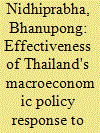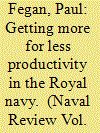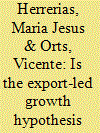| Srl | Item |
| 1 |
ID:
134024


|
|
|
|
|
| Publication |
2014.
|
| Summary/Abstract |
Collaborative defence projects have been a distinctive feature of European defence industrial policy. This article focuses on whether the number of partner nations in international collaborative defence and aerospace programmes is a source of inefficiency. It appears that there is not a simple linear relationship. Two nation collaborations can be efficient, but conventional wisdom assumes that inefficiencies emerge with more than two partner nations. Inevitably, data problems made what appears to be a simple hypothesis difficult to test. The major result is that there is no evidence that efficiency as measured by development times is adversely affected by the number of partner nations. A limited sample regression and a comparison of Airbus vs. Boeing shows a similar conclusion.
|
|
|
|
|
|
|
|
|
|
|
|
|
|
|
|
| 2 |
ID:
095043


|
|
|
|
|
| Publication |
2010.
|
| Summary/Abstract |
Empirical evidence on the effect of defense spending on US output is at best mixed. Against this backdrop, this paper assesses the impact of a positive defense spending shock on the growth rate of real GNP using a Factor Augmented Vector Autoregressive (FAVAR) model estimated with 116 variables spanning the quarterly period of 1976:01 to 2005:02. Overall, the results show that a positive shock to the growth rate of the real defense spending translates to a positive short-run effect on the growth rate of real GNP lasting up to ten quarters, but the effect is significant only for two quarters. Beyond the tenth quarter, the effect becomes negative and shows signs of slow reversal at around the 17th quarter. Our results tend to indicate that the mixed empirical evidence, based on small-scale Vector Autoregressive (VAR) and Vector Error Correction (VEC) models, could be a result of a small information set not capturing the true theoretical relationships between the two variables of interest.
|
|
|
|
|
|
|
|
|
|
|
|
|
|
|
|
| 3 |
ID:
098775


|
|
|
| 4 |
ID:
150138


|
|
|
| 5 |
ID:
141445


|
|
|
|
|
| Summary/Abstract |
The so-called Schengen compensatory measures such as the Schengen Information System (SIS) or the European Dactylographic System (Eurodac) have been the centre of much attention. However, the research on these security measures has focused almost solely on their effect on liberty, human rights, and the like. Not much attention has been given to the actual effectiveness of the security remedies taken in the European Union (EU) to compensate for the abolition of border controls, despite effectiveness being an obvious source of legitimacy in the realm of security. This article takes a first step in the direction of correcting this neglect and develops the foundations for an analytical framework focusing on effectiveness and legitimacy. The framework is illustrated through a minor analysis of the legal and institutional set-up of SIS and Eurodac as examples pointing to sources of ineffectiveness in the very set-up of the databases.
|
|
|
|
|
|
|
|
|
|
|
|
|
|
|
|
| 6 |
ID:
097826


|
|
|
|
|
| Publication |
2010.
|
| Summary/Abstract |
One of the missing pieces preventing us from understanding recent Chinese economic development is the role played by openness and capital accumulation in this process. The question is whether the sharp economic growth that the Chinese economy has experienced is another case of export-led growth due to the open-door policy or whether, on the contrary, this growth has been caused by high domestic savings and investment rates (and the consequent capital accumulation). To answer this question, we employed an empirical framework of the cointegrated vector autoregressive model. The empirical results show that both investment (in physical capital and R&D) and exports, as well as the exchange rate policy, are relevant factors in explaining China's long-run economic growth over the past 4 decades.
|
|
|
|
|
|
|
|
|
|
|
|
|
|
|
|
| 7 |
ID:
092541


|
|
|
|
|
| Publication |
2009.
|
| Summary/Abstract |
This paper tries to answer the long-standing question of whether money causes output. Instead of focusing on domestic monetary policy and output, we analyze U.S. monetary policy and its possible effects on real output in China. Our results indicate that the main monetary instrument in the U.S., the Federal Fund Rate, Granger causes China's output. A second monetary variable, U.S. money supply, does not seem to have a significant effect on China's output. The results are supported by variance decompositions, which indicate that Federal Fund Rate shocks have an effect on China's real output. The findings have important implications for policy makers in China that focus on maintaining a high and stable economic growth.
|
|
|
|
|
|
|
|
|
|
|
|
|
|
|
|
| 8 |
ID:
098339


|
|
|
|
|
| Publication |
2010.
|
| Summary/Abstract |
This paper estimates a structural vector autoregression to assess the empirical effects of terrorism on output and prices in Israel. Long-run restrictions are used to interpret the effects in terms of aggregate demand and supply curves. The responses indicate that the immediate effects of terrorism are similar to those associated with a negative demand shock. Such a leftward shift of the aggregate demand curve is consistent with the existence of adverse effects on most components of aggregate expenditure documented in previous empirical studies. The long-term consequences of terrorism are similar to those related to a negative supply shock. Such a leftward shift of the long-run aggregate supply curve agrees with adverse effects on the determinants of the potential output, such as contractions of physical capital highlighted in earlier work, as well as reductions of technological innovations and slowdowns of net immigrations, which have not been fully analyzed in the existing empirical literature.
|
|
|
|
|
|
|
|
|
|
|
|
|
|
|
|
| 9 |
ID:
086589


|
|
|
|
|
| Publication |
2009.
|
| Summary/Abstract |
In this article we examine several hypotheses relating to output and inflation dynamics in China. The hypotheses tests are based on the exponential generalised autoregressive conditional heteroskedasticity (EGARCH) model of Nelson [Nelson, D. (1991). Conditional heteroskedasticity in asset return: A new approach, Econometrica, 59, 347-370]. Our findings suggest that Chinese output-inflation behaviour is consistent with the hypothesis that increased inflation uncertainty lowers average inflation; the hypothesis that inflation volatility reduces economic growth and the hypothesis that higher output volatility increases economic growth. However, we find no support for the hypothesis that higher output volatility increases the average inflation rate.
|
|
|
|
|
|
|
|
|
|
|
|
|
|
|
|